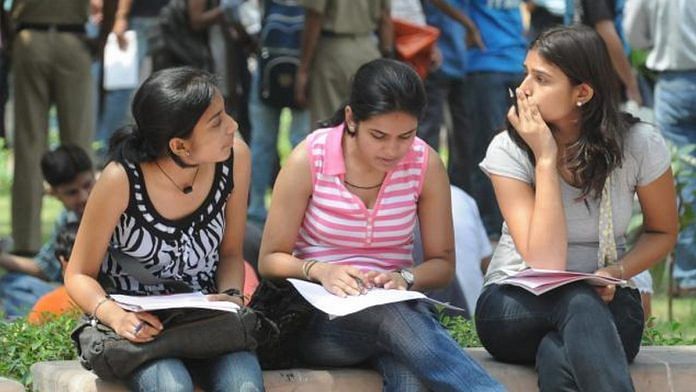New Delhi: India’s Gross Enrolment Ratio (GER) rose to 27.1 per cent in 2019-20 from 26.3 per cent in the year-ago period, said the latest All India Survey on Higher Education (AISHE) 2019-20.
GER for higher education reflects the percentage of population attending college and university out of the total eligible population — people aged 18 to 23 years.
Education Minister Ramesh Pokhriyal ‘Nishank’ released the survey Thursday. “This report provides key performance indicators on the current status of Higher education in the country,” a press statement by the Ministry of Education said.
The GER for women in 2019-20 is 27.3 per cent as compared to 26.9 per cent for men. This means that more eligible women as compared to men are attending college and university in India. Nearly 49 per cent of the total enrolment in 2019-20 consists of female students.
Increasing the GER is one of the key aims of the new National Education Policy (NEP). The Modi government wants to touch a 50 per cent GER by 2035 through various reforms included in the NEP.
What the survey reveals
Total enrolment in higher education stood at 3.85 crore in 2019-20 as compared to 3.74 crore in 2018-19, registering a growth of 11.36 lakh (3.04 per cent). In 2014-15, this figure was at 3.42 crore.
The GER for Scheduled Caste and Scheduled Tribe category stood at 23.4 per cent and 18 per cent in 2019-20, up from 23 per cent and 17.2 per cent, respectively, in 2018-19.
Apart from the GER, the Gender Parity Index (GPI), which is a comparison of the percentage of male versus female students attending higher education, also increased marginally.
The GPI for 2019-20 was at 1.01 per cent as compared to 1.0 per cent in 2018-19. This essentially means that more eligible women as compared to men are attending higher education in the country.
The growth of GPI in the last five years has been consistent. While in 2015-16, the GPI was 0.92 per cent, it has constantly risen and reached 1.01 percent in the year 2019-20.
While releasing the report, Pokhriyal said that between 2015-16 and 2019-20, there has been a 11.4 per cent growth in the student enrolment. “The rise in female enrolment in higher education during the period is 18.2 per cent,” he said.
Also read: Finish Class 12 practical and internal assessment by June end, CBSE tells schools
Subject-wise enrolment
In 2019-20, at the undergraduate level the highest number of students was enrolled in arts/humanities/social sciences courses — at 32.7 per cent, followed by 16 per cent in science, 14.9 per cent in commerce and 12.6 per cent in engineering and technology, the AISHE report said.
At the postgraduate level, the maximum number of students was enrolled in the social science stream, with science coming at number two.
At PhD level, the maximum number of students is enrolled in engineering and technology stream followed by science. The number of PhD candidates also increased by 60 per cent in the last five years.
Foreign students in India
On the number of foreign students in India, the report said that currently there are 49,348 foreign nationals enrolled in various Indian higher education institutions.
“The foreign students come from 168 different countries from all across the globe. Highest share of foreign students come from the neighboring countries of which Nepal contributes 28.1 percent of the total, followed by Afghanistan 9.1 percent, Bangladesh 4.6 percent and Bhutan 3.8 percent,” the AISHE report said.
“The top 10 countries in terms of number of students come from also includes Sudan (3.6 percent), U.S. (3.3 percent), Nigeria (3.1 percent), Yemen (2.9 percent), Malaysia (2.7 percent, United Arab Emirates (2.7 percent),” it added.
Also read: UGC’s blended learning will destroy public-funded university system: Bengal teachers’ unions



